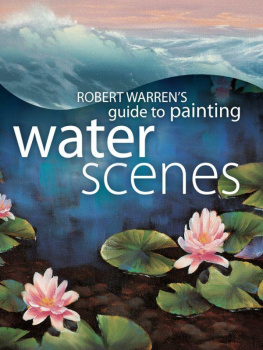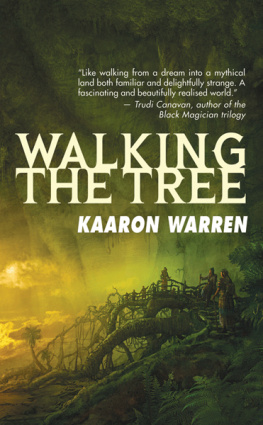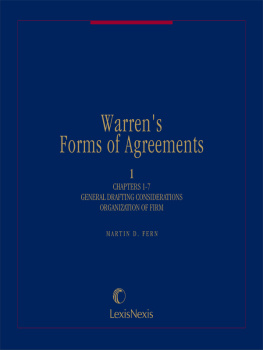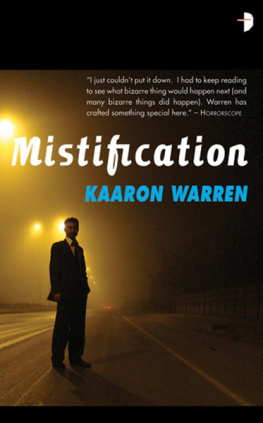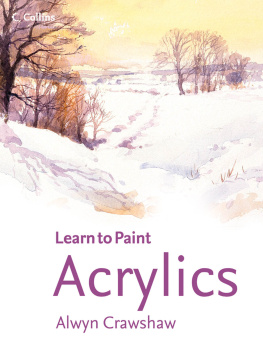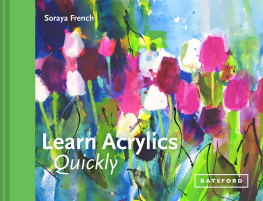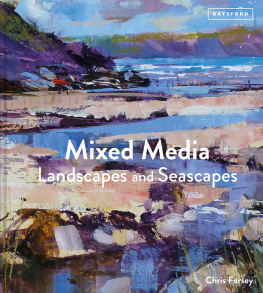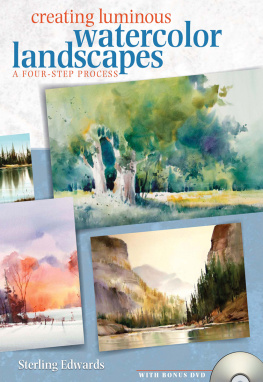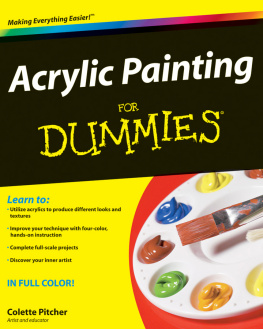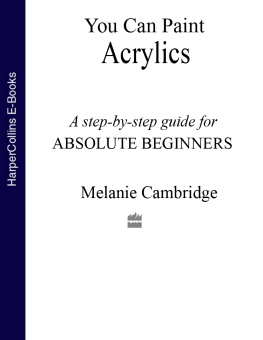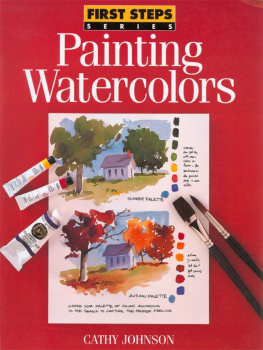
ROBERT WARRENS
guide to painting
water
scenes

NORTH LIGHT BOOKS
CINCINNATI, OH
www.theartistsnetwork.com
Robert Warren's Guide to Painting Water Scenes. Copyright 2006 by Robert Warren. Manufactured in Singapore. All rights reserved. The patterns and drawings in this book are for the personal use of the painter. By permission of the author and publisher, they may be either hand-traced or photocopied to make single copies, but under no circumstances may they be resold or republished. No other part of this book may be reproduced in any form or by any electronic or mechanical means, including information storage and retrieval systems, without permission in writing from the publisher, except by a reviewer, who may quote brief passages in a review. The content of this book has been thoroughly reviewed for accuracy. However, the author and publisher disclaim any liability for any damages, losses or injuries that may result from the use or misuse of any product or information presented herein. It is the purchasers responsibility to read and follow all instructions and warnings on all product labels. Published by North Light Books, an imprint of F+W Publications, Inc., 4700 East Galbraith Road, Cincinnati, Ohio 45236. (800) 289-0963. First edition.

Other fine North Light Books are available from your local bookstore, art supply store or direct from the publisher.
10 09 08 07 06 5 4 3 2 1
Distributed in Canada by Fraser Direct, 100 Armstrong Avenue, Georgetown, ON, Canada L7G 5S4, Tel: (905) 877-4411
Distributed in the U.K. and Europe by David & Charles, Brunel House, Newton Abbot, Devon, TQ12 4PU, England Tel: (+44) 1626 323200, Fax: (+44) 1626 323319, Email: postmaster@davidandcharles.co.uk
Distributed in Australia by Capricorn Link, P.O. Box 704, S. Windsor NSW, 2756 Australia, Tel: (02) 4577-3555
Library of Congress Cataloging-in-Publication Data
Warren, Robert.
Robert Warrens guide to painting water scenes / Robert Warren. -- 1st ed.
p. cm.
ISBN-13: 978-1-58180-851-3 (pbk. : alk. paper)
ISBN-13: 978-1-60061-615-0 (EPUB)
ISBN-10: 1-58180-851-8 (pbk. : alk. paper)
eISBN: 978-1-44031-746-0
1. Water in art. 2. Painting--Technique. I. Title. II. Title: Guide to painting water scenes.
ND1460.W39W37 2007
751.45436--dc22
2006011256
Editor: Holly Davis
Production Coordinator: Greg Nock
Designer: Clare Finney
Interior Layout Artist: Jessica Schultz
Photographer: Christine Polomsky
METRIC CONVERSION CHART
| to convert | to | multiply by |
| Inches | Centimeters | 2.54 |
| Centimeters | Inches | 0.4 |
| Feet | Centimeters | 30.5 |
| Centimeters | Feet | 0.03 |
| Yards | Meters | 0.9 |
| Meters | Yards | 1.1 |

About the Author
Robert Warren has been a professional artist for more than 30 years. Although greatly influenced by his mentor and dear friend, the late William Alexander, his ala prima style of painting and teaching has been self-taught and his style has greatly evolved and developed over the span of his career.
Robert opened his current studio, Robert Warrens Art Loft, in Canal Winchester, Ohio, in 1986. He teaches monthly seminars and classes from beginning through advanced levels to students from around the country and the world. He has produced more than 200 instructional art shows for Alexander Art, Inc. and the Martin/ F. Weber company. The Art of Robert Warren has been broadcast worldwide for over 15 years on numerous cable and Public Broadcasting Stations. He has also authored nine instructional books.
Roberts website, www.RobertWarrenArtLoft.com, includes his gallery pieces, schedules of classes, and supplies, DVDs, or instructional material available for purchase.
Dedication
I would like to dedicate this book to my wife, Donna, and our artistic children Amanda, Robin, and Shawn for their limitless love and support through many years of enduring my artistic endeavors. I would also like to dedicate this to my mother, Vera Warren, who taught me great determination and provided me with the encouragement since childhood to continue my artistic journey. Last, I would like to thank my many loyal students who over a period of 30 years have encouraged and challenged me to grow. My hope is that I have touched your life as profoundly as you have mine.
Acknowledgments
Throughout any successful career, there are always those special individuals that have driven us with the fuel of inspiration. By combining inspiration and determination with a shot of confidence, a skill is developed and a passion is born. I would like to take this opportunity to acknowledge some of the most influential people in my artistic career: Jean Dodson, my art teacher from elementary through high school. Through her encouragement, I decided to major in art in college.
Dante Vena, Ph.D., my favorite and very inspiring college art professor at Ohio University. He recently retired as the head of the art department at the University of Massachusetts, but is still going strong.
My sister Lea Myles, who also became a renowned artist after getting acquainted with William Alexander and insisted that I meet this eccentric man with so much enthusiasm for life and painting. In fact, it was Lea who wrote and coordinated the first televised how-to oil painting programs with William Alexander. Many of todays television artists owe her a debt of gratitude for introducing this new media to millions of viewers.
My dear friend, the late William Alexander, my biggest source of artistic inspiration. He taught me to make art fun and the rewards of sharing my passion with others. Although my style has drastically changed from the big mountains and pine tree paintings that Bill was known for, I still credit him for starting me on my career path.
Thanks to my editor, Holly Davis of North Light Books, for her professional yet gentle expertise in completing this book, and to Kathy Kipp for tying up all the loose ends.
contents


materials
A good painting starts with good painting tools. The next few pages describe the paints, mediums, brushes and other materials I use and recommend. My materials list isn't long or complicated, but using these items can make all the difference in your painting. For help finding these materials, see "".

Robert Warrens Luminous Orange
The goal of every painting is to capture light. I start almost all my oil paintings on an orange acrylic canvas. I came up with this idea about ten years ago after closely studying the work of Peter Paul Rubensso closely in fact that I accidentally set off a museum alarm. I determined that Rubens work had a certain luminous quality that many others from the same era did not. This luminosity seemed to come from within the painting rather than from the oil paint alone. I realized he had started his paintings on a toned canvas.
Next page
